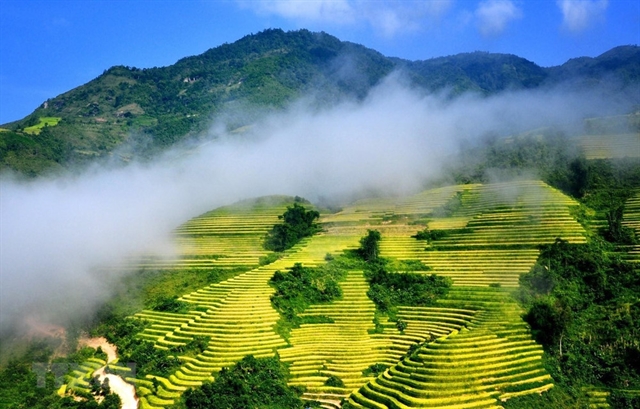 Features
Features

Vũng Bọt Stream at the junction of the Bắc (North) and Nam (South) rivers that merge the Cu Đê River is home to the 'niên' fish (Onychostoma gerlachi), a natural freshwater fish species that is listed as Near Threatened on the IUCN Red List of Threatened Species.
By Công Thành
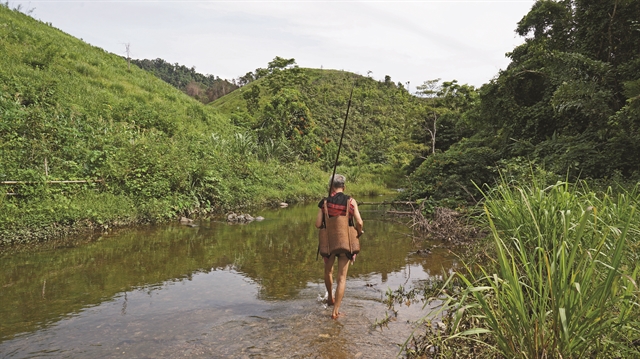
|
| An ethnic Cơ Tu man begins a day fishing in nature. The ethnic group use traditional tools to catch fish for food in central Việt Nam. — Photo courtesy of Rose Travel |
Vũng Bọt Stream in central Việt Nam forms at the intersection of the Bắc (North) and Nam (South) rivers that merge with the Cu Đê River and is home to the niên fish (Onychostoma gerlachi).
This natural freshwater fish species is listed as Near Threatened on the IUCN Red List of Threatened Species, but forms a key part of the culture of the Cơ Tu ethnic group in Quảng Nam and Đà Nẵng, where it is used for food, particularly at major festivals.
It can be prepared in many different styles, including boiled, steamed, raw and as a mixed salad, but grilled fish is the favourite option with the best taste that showcases the unique style of the Cơ Tu, who largely reside in central Việt Nam.
Bùi Văn Siêng, 76, a Cơ Tu man, said the community believes the fish is a precious gift from heaven, so it is strictly hunted for family use only.

|
| A 'niên' fish (Onychostoma gerlachi), a natural freshwater fish species, is measured for conservation research at the Cơ Tu ethnic community in Tà Lang and Giàn Bí villages of Đà Nẵng. — Photo courtesy of Chu Mạnh Trinh |
"Local fisherman previously used crossbows or catapults to catch fish upstream. The fish could be easily found in mass in Vũng Bọt Stream. You could feel them hit your feet when crossing," Siêng said.
The fish is symbolic culture of the Cơ Tu in Quảng Nam, particularly for about 1,000 people in Tà Lang and Giàn Bí villages, who have preserved their ethnic living style for more than half of century since they migrated here in the late 1960s.
The fish is sold at VNĐ250,000 (US$11) to VNĐ500,000 per kilogram at restaurants, making it the most hunted fish in the rivers of the central region.
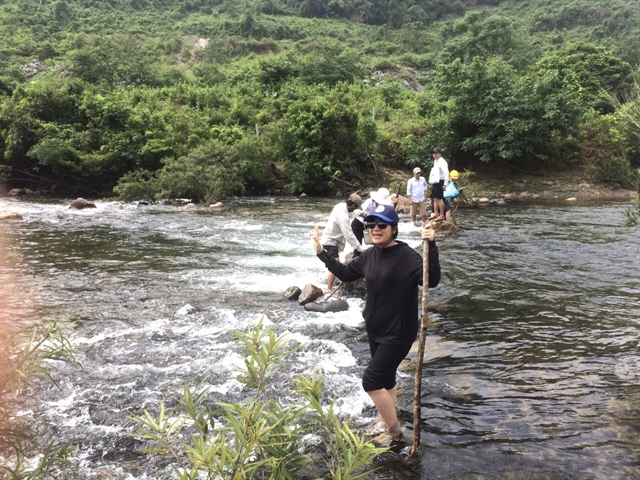
|
| Tourists cross Vũng Bọt upstream in Tà Lang Village -- home to the Cơ Tu ethnic minority in the suburbs of Đà Nẵng City. The village has been doing the community-based tourism. — Photo courtesy of Hoà Bắc community-based tourism |
Bùi Hoài Vũ, a local fish hunter and guide, said fishermen had to hold their breath for a six-metre deep dive to catch fish by handmade crossbows or tridents.
"Fishing with rudimentary tools is a harvest leisure activity of the Cơ Tu. We catch fish when going swimming or reserve it for food. It's not for sale," Vũ said.
"Previously, we used to catch mature fish weighing from 200 to 300 grams each, while smaller ones or fish in the breeding season were released. Electric shocks can kill mature and small fishes at the same time. Illegal poachers even fish in the rainy breeding season."
Vũ said the fish population had seriously declined in recent years due to poor management of fishing activities.
"Previously local hunters could catch several kilos of fish in an hour, but now only two or three fish are collected. Mass fish swimming upstream for reproduction in the rainy season is rarely seen by now," he said.
Fish guard team
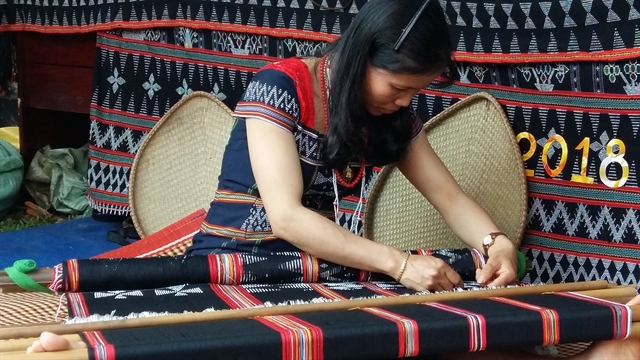
|
| An ethnic Cơ Tu woman does brocade weaving in Giàn Bí Village of Hòa Bắc Commune in suburban Đà Nẵng. The craft serves community-based tourism in the village. —VNS Photo Lê Lâm |
To protect the fish species, scientists and conservationists have been working with the Cơ Tu community and local administration on a programme to sustain the population of the rare fish.
The Niên Fish Conservation project, which received funding from the United Nations of Development Programme through the Global Environment Facility's Small Grants Programme to preserve Cơ Tu ethnic culture and conserve the Bà Nà-Núi Chúa nature reserve, was born in late 2021.
The first fish protection team was established with 30 members, mainly previous local hunters from Tà Lang and Giàn Bí villages.
The team was assigned to educate the locals on the use of traditional fishing tools and warning against fishing by electric shocks.
A Lăng Như, a member of the team, said the ethnic Cơ Tu people did not have a habit of electric-shock fishing, but fishermen from other areas do it.
Như said that electric shock fishing apparently resulted in a drop in the fish population in Tà Lang and Giàn Bí.
Thái Văn Hoài Nam, chairman of the Hòa Bắc Communal People's Committee, said the Niên Fish Conservation project was an urgent plan to save the fish species from extinction.
The project also aims to develop community-based eco-tourism, highlighting the craftwork of the Cơ Tu people and education on sustainable fishing.
A report released by the Hòa Bắc authorities showed that traditional methods using a crossbow, fishing rod or net made up about 90 per cent of local fishing, while 10 per cent used electric shocks.
However, just a small percentage of electric shock could lead to a severe reduction in the fish population, which could soon be extinct.
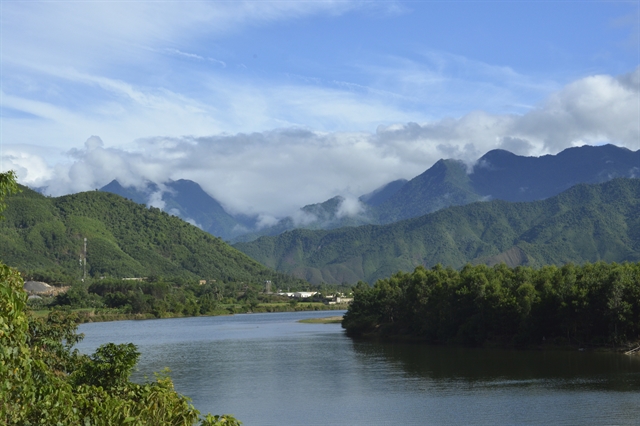
|
| The Cu Đê River in the upstream area of Hòa Bắc Commune in Đà Nẵng. The river is home to 'niên' fish, the 'near threatened' freshwater fish species. Photo courtesy of Bùi Văn Tuấn |
Chu Mạnh Trinh, a conservationist, said local governments and the wider community had been building community-based tourism to promote the conservation of the fish, Cơ Tu culture and crafts, such as handloom weaving and bamboo wickerwork, cuisine and lifestyle.
Trinh said Cơ Tu ethnic community-based tourism services were also building links with the Chàm Islands (a world biosphere reserve site in Quảng Nam), Hội An's sustainable suburban areas, wetland and mangrove forests in Quảng Ngãi, and Sa Huỳnh Culture.
Such links aim to form a circle of heritage and a sustainable value chain for international education and experience tours.
Tà Lang and Giàn Bí villages are located in a vast valley between the two nature reserves of Bạch Mã in Thừa Thiên Huế and Bà Nà-Núi Chúa of Đà Nẵng, 40km west of Đà Nẵng City, so it is easy to create connectivity with tourism hubs in the central region.
The niên fish species is part of the traditional culture of the Cơ Tu people and helps serve community-based tourism. Fish conservation helps promote sustainable fishing among communities in central Việt Nam and creates experience sites for international conservationists and sustainable tourism studies. VNS




